From Observation Sorties to Multi-Role Fighters
The Finnish Air Force is one of the oldest aerial warfare service branches in the world to operate without interruption since its establishment in 1918.
Air Force history topics:
Beginnings of the Finnish Air Force (1918)
The New Service Finding Its Direction (the 1920s and 1930s)
The Supersonic Era Begins (the 1960s)
All-Weather Combat Capabilities Achieved (the 1970s)
Fighter Capabilities Strengthened (1980-95)
The Hornet era (from 1995 onwards)
Beginnings of the Finnish Air Force (1918)
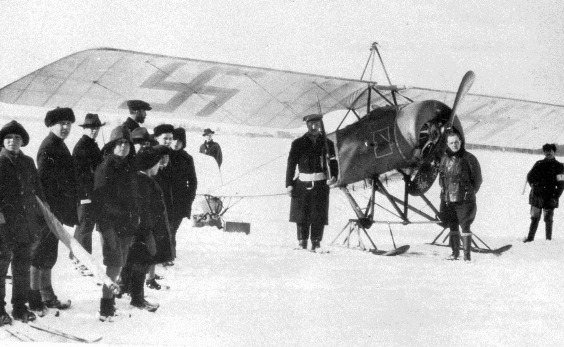
A Thulin typ D, the first FINAF aircraft, shown here in the city of Vaasa, March 1918. Photo: Finnish Air Force
Before Finland became an independent state, military aviation in Finnish territory was conducted by the Imperial Russian Air Service.
Development of Finnish military aviation was sparked by the commencement of hostilities between the Finnish Red Guards and the Whites commanded by General C.G.E. Mannerheim in January 1918, after the Russian revolution.
Late in the winter of 1918, the Whites received aircraft as donations from Sweden, and it is the air troops equipped with these planes that constituted the foundation for the Finnish Air Force. The first of these aircraft to reach Finland, arriving in late February that year, was a NAB Type 9 Albatros, a reconnaissance and training plane; however, its ferry flight to Vaasa was cut short at Pietarsaari by engine failure.
Thus, it is the Thulin typ D reconnaissance plane that is generally credited as the first aircraft of the Finnish Air Force. It arrived at Vaasa on 6 March 1918.
The date has since been celebrated as the founding date of the Finnish Air Force. The aircraft came as a donation from the Swedish Count Eric von Rosen, with the Count's personal good luck symbol – a right-facing blue swastika – painted on its wings. This swastika variant was then adopted as the national insignia for all FINAF aircraft until the year 1945.
In the very early days, the aircraft inventory of the Service comprised a miscellany of donated or procured aeroplanes along with Russian military aircraft often obtained as a by-product of pilot defections.
In addition to getting aircraft from abroad, the new Service also recruited foreign personnel: among the first FINAF pilots and commanding ranks, there were officers from Sweden and Germany, for example.
During the war of 1918, the Air Force's operations were still rather small in scale, featuring reconnaissance patrols, bombing sorties and leaflet drops made with miscellaneous aircraft operating out of temporary facilities set up on ice-covered lakes and open fields.
The FINAF force structure in 1918 consisted of two flight detachments, one based at Kolho in North Pirkanmaa and the other at Antrea in the Viipuri Province. The early post-war period saw the commencement of Air Force reorganisation into an air station structure, where the flying units operated from a land air station at Utti in North Kymenlaakso as well as water air stations at Sortavala and Koivisto in Karelia and the island of Santahamina in Helsinki where, in the area that today is home of the Guard Jaeger Regiment, there were both a harbour for floatplanes and a runway on land.
Already at the outset, the Finnish Air Force was formed into a separate organisation with an independent Service status, as opposed to being developed as part of the Army or Navy as in many other countries.
The New Service Finding Its Direction (the 1920s and 1930s)
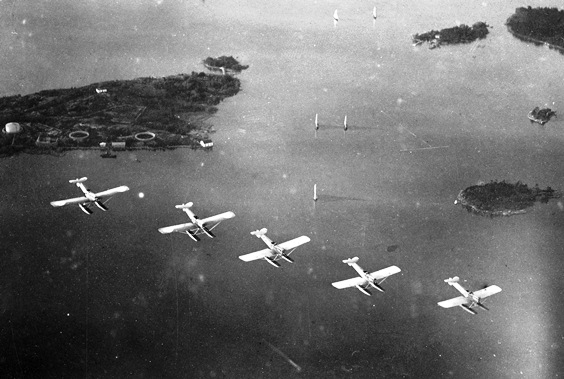
The Hansa-Brandenburg reconnaissance aircraft were the mainstay of the Finnish Air Force during the 1920s and 1930s when the focus was on maritime air operations. Photo: Finnish Air Force
Once the war of 1918 was over and circumstances in the newly independent country became more stable, Finland began to formulate the principles for how to use its air arm.
Whilst World War I was still on, the Air Force dispatched its personnel to the German Empire for training. After the collapse of the Empire, instructors were recruited from France in 1919.
This was followed by a period of British influence beginning from the mid-1920s and lasting until World War II. During this time, the Air Force commissioned experts from the UK and also sent its own people there for training purposes.
In the early 1920s, the focus of FINAF development was on maritime aviation, since it was then considered that the primary task of the Finnish air arm was to conduct observation, reconnaissance and surveillance operations relying on Finland's territorial waters and thousands of lakes.
This is why the Air Force chose floatplanes as its first major equipment acquisition. The aircraft in question was the IVL A.22 Hansa. Beginning from 1922, the company Ilmailuvoimien Lentokonetehdas ("Air Force Aircraft Factory"), predecessor of what is today known as Patria, built as many as 122 Hansas based on a licence from Germany.
Overall, the Air Force continued to procure equipment with a diverse approach. Different types of aircraft were acquired from abroad in small quantities, whether to serve as basis for licensed production or to provide inspiration for domestic aircraft building. Production of aircraft designed and built in Finland commenced in 1928 with the "Sääski" ("mosquito") training plane.
Although seaplanes dominated the military aviation scene at the time, land-based operation made strides as well. In 1923, the Air Force started organising fighter pilot training courses.
In addition to the maritime squadrons, the Air Force organisation of the 1920s featured land-based squadrons with fighter and bombing capabilities organised in accordance with the division of forces into air stations.
The reign of maritime air operations ended in the 1930s, as the Air Force redefined its development philosophy to shift the focus on land-based aircraft. Development of fighter aircraft competencies, particularly fighter tactics adapted to the domestic context, was boosted by the 1927 introduction of the Gloster Gamecock, the British-designed fighter plane built under a license in Finland.
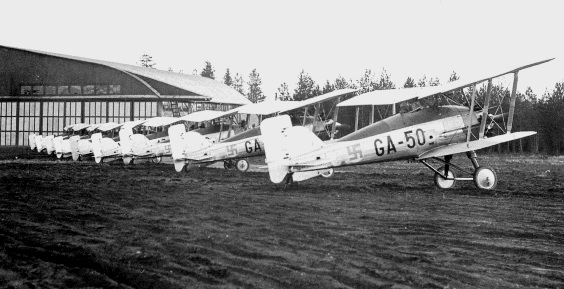
Introduction of the Gloster Gamecock in the late 1920s strengthened the Finnish Air Force's competencies in fighter aircraft operations. Photo: Finnish Air Force
The FINAF training arrangements were realigned in the same conjunction. In 1929, the Air Force Academy, originally based at the Santahamina garrison in Helsinki, was relocated to the Ostrobothnian locality of Kauhava, training both flying personnel and aircraft maintenance professionals for active duty as well as reserve.
In the 1930s, the fashionable air war doctrine of the time, Douhetism, influenced Finnish military aviation as well. Douhetism held it that military conflicts were decided by a strong air arm with offensive capabilities, relying on efficient bombers as its main equipment. This was also reflected on materiel acquisitions and the FINAF organisation of that time, both of which leaned rather heavily on bomber aircraft.
As the threat of a major war became apparent, the Finnish Air Force initiated in 1936 an extensive preparation programme to acquire, both by way of procuring and building under license, new equipment for the fighter squadrons, joint operations squadrons and remote operations squadrons established under the revamped aviation regiment structure.
In the course of the programme, the Air Force acquired Fokker D.XXI fighters and Fokker C.X scout and light bombers from the Netherlands as well as Bristol Blenheim light bombers from the UK.
However, the air armament programme had not reached completion by the time the international political atmosphere grew increasingly tense in the 1930s, as a result of which military aircraft acquisitions dried out. At any rate, the purchases made in connection with the programme were of key significance for Finland's military capability in the Winter War that broke out in November 1939.
The War Years (1939-1945)
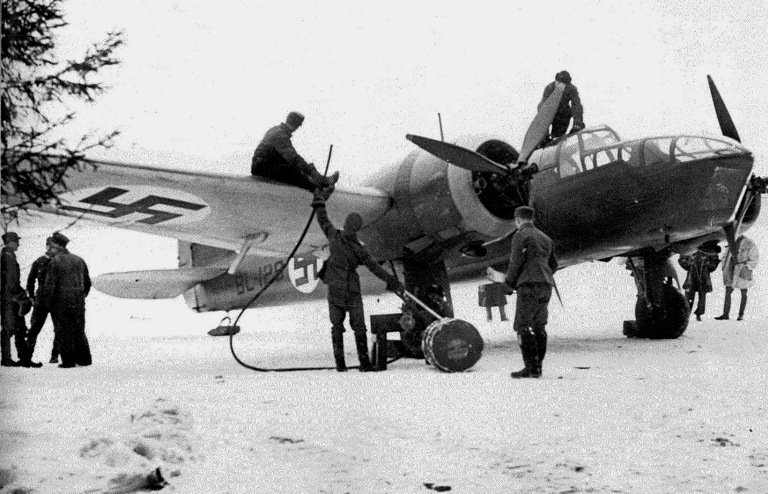
A Bristol Blenheim light bomber is being refuelled at Luonetjärvi, Central Finland in late winter 1940. Photo: Finnish Air Force
The Finnish Air Force faced its ordeal by fire in the Winter and Continuation Wars. The Service's materiel readiness was poor particularly in the early stages of the conflicts, but the high standard of personnel training made up for the deficiencies.
WINTER WAR
World War II began in September 1939 when Germany invaded Poland. During the autumn, the threat of war between Finland and the Soviet Union became more and more imminent.
The Winter War started on 30 November with an extensive aerial bombardment campaign launched on Finnish cities and towns. Finnish fighters were scrambled to intercept bombing sorties already on the first day of war, but it was only on the following day, 1 December, when the first aerial combats took place.
The Air Force's combat readiness was less than optimal at the outbreak of the Winter War, as it only had limited quantities of up-to-date aircraft available due to the unfinished development programme.
Finland's flying forces were faced with the daunting task of countering the initial strength of more than one thousand combat aircraft of the Soviet military – which was more than doubled in later stages of the war – with their just over one hundred planes in operating condition.
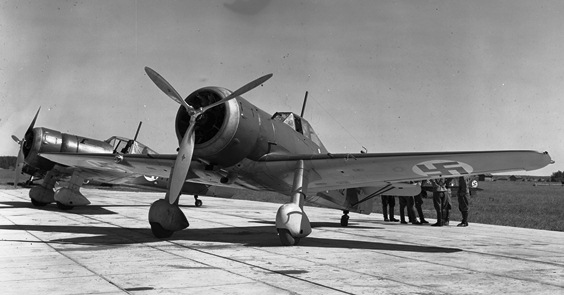
The Fokker D.XXI was the Air Force's principal fighter in the Winter War. Photo: Finnish Air Force
The Air Force saw its materiel situation improve during the war with the acquisitions of new aircraft both by way of purchases (including the Brewster Model 239, Fiat G.50 and Hawker Hurricane fighters) and as donations (including the Morane Saulnier M.S. 406 fighters). But the end of the hostilities in March 1940, 105 days into the war, meant that there was not enough time to introduce all of the new materiel such as the Brewster fighters procured from the U.S. into full-scale operational use.
In the Winter War, the Air Force was tasked with countering the Soviet air offensives with fighter forces particularly behind the front and in the home territory. Additionally, bomber and scout aircraft were harnessed for reconnaissance patrols vital for determining the front situation as well as for raids targeted a short distance in rear of the Soviet lines. Regrettably, due to the poor aircraft availability, the Air Force only had a very limited capacity to execute direct attacks in support of own ground troops.
Towards the end of the war, aircraft availability was ameliorated with the addition of more than one hundred fighters and bombers through procurements and donations. In March 1940, FINAF aircraft was concentrated to counter both the Soviet ground offensive launched at Viipurinlahti and attacks on the Finns’ rear positions on the Gulf of Finland.
During the Winter War, the Air Force recorded more than 300 aerial victories against 62 of its aircraft destroyed and 35 damaged. More than 300 further aircraft were shot down by the Finnish anti-aircraft defence. In all, 75 members of the Service were killed or missing in action.
Ten FINAF pilots achieved five or more aerial victories in the Winter War, which in the international context is generally considered as the requirement for official qualification as an "ace". The most acclaimed Finnish fighter pilot of the war was Lieutenant Jorma Sarvanto, a Fokker pilot who amassed 13 aerial victories. On 6 January 1940, in the course of an air battle that lasted only 4-5 minutes, Sarvanto shot down six Ilyushin DB-3 bombers, a world record in its own right.
The fight of the Finns generated a lot of compassion internationally, and the Air Force received voluntary aid from abroad, in addition to materiel donations. For example, the F19 aviation regiment consisting of Swedish volunteers played a considerable role in counter-air, bombing and aerial reconnaissance missions in Northern Finland.
CONTINUATION WAR
The Winter War, which ended in March 1940 and resulted in territorial cessions from Finland to the Soviet Union, was followed by an interim peace, during which Air Force armaments were actively improved.
The State Aircraft Factory repaired damaged aircraft and built new ones under licences. Additionally, the types of aircraft ordered during the Winter War but only received after it were now made available for use. Moreover, Germany, in the context of building closer relations with Finland during the interim peace, supplied the Finnish Air Force with aircraft conquered from its enemies on different battlefronts.
Measures undertaken during the peace period included build-up of anti-aircraft defences, improvements in the standard of equipment at air bases and development of air defence command and control systems.
Finland implemented a mobilisation of its armed forces in June 1941. The aerial war of 1941 began as Germany invaded the Soviet Union on 22 June, commencing aerial operations also in Finnish territory, where German flying forces had been stationed since the beginning of June; full responsibility of all aerial military operations in North Finland had been given to Luftflotte 5.
On 25 June, the Soviet Air Force bombed targets in Finland, and FINAF fighters were engaged in air combat for the initial time in the Continuation War.
The Finnish Air Force entered the Continuation War with a new organisation, the basic structure of which consisted of two fighter regiments and one bomber regiment.
Furthermore, one aviation regiment operational in the Winter War was divided into three joint operations squadrons placed under the commanders of the combined arms formations, and one maritime reconnaissance squadron was established for anti-submarine operations under the commander of the Finnish Navy.
The main types of fighter aircraft were the Brewster, the Fiat, the Fokker D.XXI, the Morane M.S. 406 and the Curtiss Hawk, while the Fokker C.X was the main scout and light bomber aircraft and the Bristol Blenheim the most important bomber aircraft. The Air Force had a total strength of 550 aircraft.

A fighter originally designed for aircraft carrier operation, the Brewster never achieved substantial success while serving its country of origin, the USA, but proved highly effective for the Finnish Air Force in early stages of the Continuation War. Captain Hans Wind, one of the most prominent FINAF ace pilots, shown here on board his Brewster in 1943. Photo: SA-kuva
In the initial stages of the Continuation War, the Air Force was able to focus on supporting the fighting of the field army as it advanced on the Karelian Isthmus, Syväri and the Maaselkä Isthmus, since the air threat against home territory was less substantial than during the Winter War. The Air Force also had clear air superiority on the battlefront, because the Soviet Air Force had to divide its strength in its efforts to counter the German-lead Operation Barbarossa in the more southern areas of the country.
The front lines of the belligerents became more or less fixed by the end of December the same year, and a two-year period of position warfare ensued. During this time, the Air Force reorganised its structures in order to meet the demands of the new situation.
Mixed regiments consisting of fighter squadrons and reconnaissance squadrons were formed on the Aunus Isthmus, in the Ääninen and Maaselkä area and on the Karelian Isthmus, in addition to which there was a remote operations and bombing regiment operating in the area. Additionally, an aviation regiment was formed to protect South Finland and the Gulf of Finland.
During the position warfare period, the Air Force carried out reconnaissance sorties and supported the fighting of all services through a variety of measures such as bombing raids, air assaults and transportations of long-range reconnaissance patrols, while providing friendly ground troops with air support and protecting the home territory through counter-air operations.
The intensity of aerial activity was lower than in the offensive phase, which gave the Air Force a valuable opportunity to develop its operations. An example of this were the improvements made in the fighter operations command and control system.
During the period, the Air Force equipped itself with new aircraft, of which the most capable were the German-made Dornier Do 17 and Junkers Ju 88 bombers and the Messerschmitt Bf 109 fighters. The new equipment was needed as well, as the types of aircraft used by the Air Force in the early stages of the Continuation War began to be both outnumbered and outperformed by the Soviet Air Force that was getting better and stronger as the war went along.
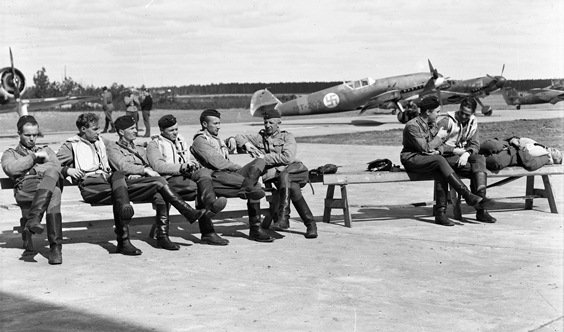
Messerschmitt Bf109 fighters acquired from Germany were the best fighter aircraft of the Air Force in the defensive battles fought late in the Continuation War. FINAF pilots on stand-by at their aircraft at Utti in 1943. Photo: Finnish Air Force
The State Aircraft Factory also carried out a lot of development on the existing aircraft in addition to devising and implementing planes of its own design (albeit on a small scale), including the Humu, a wood-winged copy of the Brewster, and the all-wooden fighters Myrsky and Pyörremyrsky.
Finland's position warfare ended in a major Soviet offensive that commenced on 9 June 1944. During the offensive, the Finns retreated on the Karelian and Aunus Isthmuses and in East Karelia. The Air Force participated in countering the offensive with fighter sorties around the clock and bombing raids featuring detachments of up to dozens of bomber aircraft.
The Finnish air defence battle received a significant boost from Detachment Kuhlmey, a unit of the German Luftwaffe operating out of the Immola airfield with fighters, fighter-bombers and dive bombers.
The defenders managed to halt the attackers’ advancement on the Karelian Isthmus in the battle of Tali-Ihantala fought between 25 June and 9 July, and they also successfully countered the attempted attack across the Bay of Viipuri as well as the offensive at Vuosalmi continuing until 17 July.
In the course of the Continuation War that ended in an armistice in September 1944, FINAF aircraft achieved 1,600 aerial victories and delivered more than 3,000 tonnes of ordnance. Ground-based air defence destroyed 1,030 aircraft and the Finnish Navy a further 75.
The Air Force lost 182 aircraft destroyed in action or otherwise damaged beyond repair and 160 aircrew members as casualties and a further 24 as prisoners of war. As many as 155 pilots achieved aerial victories. Of them, 87 were credited with at least five victories, qualifying officially as flying aces. In proportion to national population, the number of Finnish flying aces is a world record.
Finland's top flying aces in the war were Warrant Officer Eino Ilmari Juutilainen and Captain Hans Wind, with 94 and 75 aerial victories, respectively.
The success of Finnish pilots in the Winter and Continuation Wars has been attributed to a number of reasons. Considered as one of the key factors in this was the development of air combat tactics and air defence command and control commenced in the 1930s by Colonel Richard Lorentz and Colonel (later Major General) Gustaf Erik "Eka" Magnusson and continued during the war. This work was regarded as highly progressive even by international standards.
The principles formulated by Lorentz and Magnusson held it that it was necessary to develop the command and control system and air situation picture for the fighter aircraft to enable flexible utilisation of a small flying fleet in order to gain air superiority when fighting against an adversary superior in force at the points of main effort.
Moreover, they underlined the significance of high-quality fighter tactics training and air-to-air shooting training in military pilot training.
LAPLAND WAR
For the Finnish Air Force, World War II ended in the Lapland War that began in October 1944. In the conflict, Finnish forces drove the German troops situated in northern Finland out of Finnish territory through military action, in accordance with the terms of the previously established armistice between Finland and the Soviet Union.
A special detachment consisting of fighter and bomber aircraft was formed in North Finland, tasked with supporting the Finnish Army's battle by way of counter-air, aerial reconnaissance and bombing sorties. This was a demanding operation, owing to long distances, inclement weather, sparse network of bases and a shortage of personnel resulting from demobilisation of troops in conjunction with the armistice. Additionally, the Germans had good numbers of high-quality aircraft at their disposal.
Hence the high rate of attrition: by the time the operation was over in April 1945, the special detachment had lost 10 aircraft out of 60. Sixteen crew members were lost as casualties, and two were caught and imprisoned. The final sortie for the Finnish Air Force in the Lapland War – and World War II in general – was flown by a Dornier bomber on an aerial photography mission on 4 April 1945.
Reconstruction (1945-60)

The Valmet Vihuri advanced training aircraft helped the Air Force to get past the difficult post-war years. Its development relied as extensively as possible on existing aircraft materials remaining from the war. Photo: Finnish Air Force
The end of the Continuation War brought Air Force operations to an almost complete stop. An aviation ban imposed by the Allied Control Commission, effective from the armistice of autumn 1944, interrupted all FINAF training and exercise activities until lifted in August 1945.
The arrival of peace also meant equipment reductions and operational changes across the Service.
The Paris Peace Treaties signed in 1947 regulated, among other things, that the Finnish Air Force was to have no more than 60 combat aircraft and a maximum strength of 3,000 persons. The treaties also banned the Air Force from having aircraft with internal bomb bays as well as guided missiles and atomic weapons.
Furthermore, the swastika symbol inherited from Count von Rosen was replaced by the blue-and-white roundel that continues to serve as the national insignia of FINAF aircraft to this day.
The restrictive requirements led to substantial reductions in numbers of aircraft remaining from the war and departure of Air Force personnel to civilian work.
Most of the bomber aircraft and older fighter aircraft were scrapped. Subsequently, the Air Force was left with around one hundred Messerschmitt Bf 109 fighters worn down by intensive use during the war, and they constituted the mainstay of the Service.
The year 1952 saw the reorganisation of the Air Force; the four peace-time aviation regiments established in late 1944 were replaced with three wings situated at Luonetjärvi in Tikkakoski, Central Finland, Pori in Western Finland and Utti in South-East Finland. These forces were subsequently named Häme, Satakunta and Karelia Air Wings, respectively, and their primary tasks were counter-air operations, flying training and reconnaissance.
International military aviation evolved at a rapid pace in the post-WW II years. New jet fighters had got their first taste of air combat already during the war and ultimately replaced the less capable propeller-driven aircraft equipped with reciprocating engines.
Although actively trying to stay apace with the evolution, it wasn't until the late 1950s when the Air Force was truly able to take part in it.
A key milestone in the modernisation of the Service was the 1951 introduction of the Vihuri advanced training aircraft, designed and built by the State Aircraft Factory. The Vihuri was involved in a number of accidents that were widely publicised as well, but it was nevertheless significant for the Air Force. It brought much-needed relief into the equipment situation and kept the wheels of flying training rolling until the decade's end.
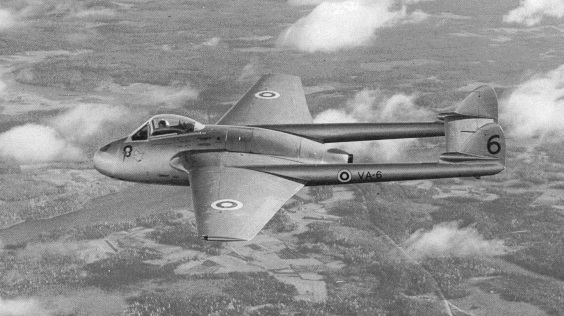
The jet aircraft era began in the Air Force with the de Havilland Vampire. Photo: Finnish Air Force
In 1953, the Air Force received its first jet aircraft by procuring de Havilland Vampire fighters from the UK. The Vampire was succeeded by the Folland Gnat, a more capable jet fighter, again from the UK, acquired in 1957. Interestingly, a Gnat broke the sound barrier for the first time in Finland.
Two further acquisitions were made in 1958, both of them proving extremely worthwhile over time. The Saab Safir trainers and the Fouga Magister jet trainers were in service until the 1980s. They provided a good foundation for training pilots towards handling the increasingly capable fighter aircraft to enter service in the coming decades.
The same year, the Air Force retired the last aircraft type it had remaining from the war, the Bristol Blenheim light bomber.
Construction of an up-to-date air surveillance radar network covering the entire country as well as air defence command and control centres located in underground facilities also commenced in the 1950s.
The Supersonic Era Begins (the 1960s)
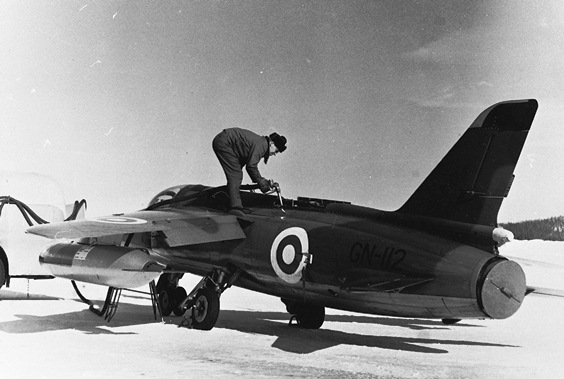
The Folland Gnat was a rather capable jet fighter in the environment of the late 1950s when the Air Force made the acquisition. However, it did not fully live up to the challenges posed in the next decade. Photo: Finnish Air Force
Entering the 1960s, the rapid pace of development in aviation technology placed increasing demands on the surveillance ability of Finnish air defence and the capability of FINAF aircraft.
In the new situation, there were flying objects moving in airspace at many times the speed of sound and at altitudes as high as tens of thousands of metres.
As of the beginning of the 1960s, the Air Force only had a limited capacity for responding to the new air threats. The Service's best-performing aircraft were the 12 Gnat fighters that were only capable of reaching subsonic speeds in level flight and had a service ceiling of 12 km. Similarly, the surveillance and command and control system failed to meet all of the requirements of the time.
The situation improved in 1962, when the Air Force acquired a squadron's worth of MiG-21F fighter and interceptor aircraft from the Soviet Union. They were assigned to Karelia Air Wing at Rissala, North Savonia (the wing having been transferred there from Utti) and Häme Air Wing at Luonetjärvi, Central Finland.
The MiG-21F was an up-to-date and capable fighter at the time of acquisition, even in international comparison; it achieved Mach 2 and its service ceiling was almost 20 km. Its combat capability was improved with the K-13, an infrared homing air-to-air missile that the Air Force was allowed to procure pursuant to a negotiated amendment of the Paris Peace Treaties.
In addition to improving its interceptor aircraft capabilities, the Air Force also made great strides in the development of its command and control, surveillance and support systems. The air surveillance radar network had been built to cover the entire country already in the 1950s, but its surveillance capability was substantially improved with the long-range surveillance radar equipment acquired in the 1960s.
The same decade saw the construction of control and reporting centres to serve as air defence command and control posts, situated in underground facilities in connection with FINAF wings.
The Air Force also commenced efforts to prepare for the establishment of dispersed road bases around the country to be used in times of crises.
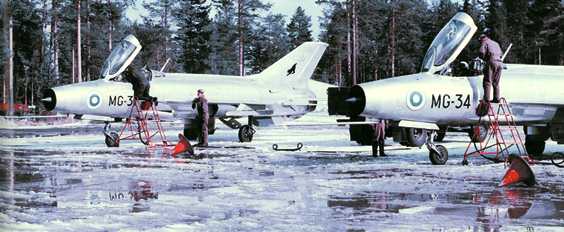
The MiG-21F belonged to the international elite of interceptor aircraft at the time of acquisition. Photo: Finnish Air Force
Two new FINAF units were established during the 1960s: the Transport Squadron at Utti, separated from Karelia Air Wing, and the Aircraft and Weapon Systems Training Wing, separated from the Kauhava-based Air Force Academy as an independent training installation.
The Air Force Communications Battalion, having been transferred from Hämeenlinna to Luonetjärvi, became the Air Force C3 Systems School. Furthermore, the Air Force Test Flight, whose operations had commenced at Härmälä in Tampere before the wars, was relocated to Halli in Kuorevesi.
Beside the MiG fighters, the Air Force introduced two other types of aircraft. The first-ever helicopters of the Finnish Defence Forces, the Polish-built SM-1s, served the Air Force for four years. Additionally, jet-engined Ilyushin Il-28 bombers were acquired from the Soviet Union for target-towing and surveillance duties.
All-Weather Combat Capabilities Achieved (the 1970s)
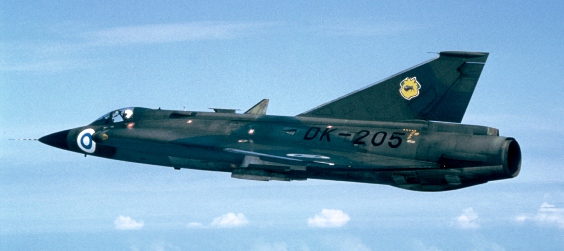
Procurement of Saab Draken fighter aircraft from Sweden gave the Air Force the capability for combat operations under all weather conditions. Photo: Finnish Air Force
The 1970s have been characterised as the decade when the Air Force finally reached a contemporary standard with respect to both its aircraft and operations after the post-war rebuilding phase.
Aircraft acquisitions played a key role in the improvement of FINAF capabilities in the 1970s. With the introduction of the Swedish Saab Draken fighter in 1972, the Air Force took a major step ahead and also achieved the capability of carrying out combat operations in any weather.
The main new features of the Draken compared with previous FINAF aircraft were the radar and the semi-active radar homing missiles enabling for the first time air-to-air operations in any weather and light circumstances.
Moreover, with the Draken it was possible to launch missiles at approaching targets, compared with the previous aircraft that were restricted to only rear sector attacks.
With the arrival of the Draken, the area covered by air defence expanded. Previously the Air Force had based its most capable aircraft mainly in Southern Finland, but now Häme Air Wing was equipped with Drakens that replaced the Gnats and the wing was relocated to its new main operating base at Rovaniemi. It was later renamed Lapland Air Wing.
Beginning in 1978, the Air Force's all-weather combat capability was reinforced further through acquisitions of the MiG-21bis, a new radar-equipped version of the fighter and interceptor aircraft. These new aircraft were assigned to Karelia Air Wing at Rissala, where they joined the formerly acquired Soviet jet fighters.
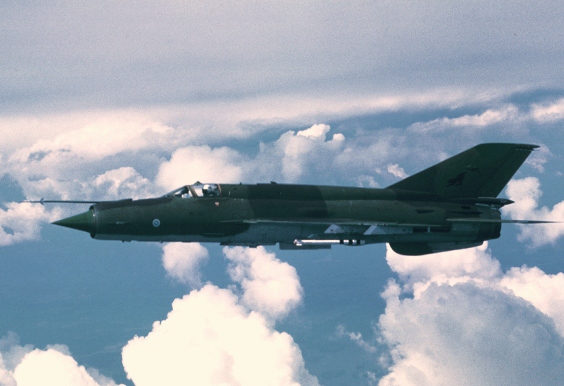
The Soviet-built MiG-21bis fighter-interceptors, along with the Drakens, comprised the main fleet of the Air Force until the mid-1990s. Photo: Finnish Air Force
In addition to the aircraft acquisitions, air defence capabilities were improved with a domestic scheme to develop new low altitude surveillance radars and with the procurement of the first surface-to-air missiles for Army troops.
Organisational changes carried out in the Air Force during the decade included the above-mentioned relocation of Häme Air Wing and the relocation of the Aircraft and Weapon Systems Training Wing from Kauhava to Halli in Kuorevesi. The Air Force Command was transferred from Helsinki to underground facilities at Luonetjärvi in Tikkakoski in 1972.
Among developments commenced in the 1970s was the construction of a new base for Satakunta Air Wing in Pirkkala to replace their existing facilities in Pori.
The same decade also saw the Air Force begin to replace its basic and advanced trainers dating back from the 1950s with new equipment suitable for the demands of the new fighters.
Development started towards the construction of the Valmet Vinka, a primary and basic trainer aircraft of Finnish origin, in a scheme dubbed LEKO-70 and the acquisition of a jet trainer as successor to the Fouga Magister. Selected for the role was the Hawk from the UK. In the course of the selection process, a careful evaluation of the short-listed aircraft was carried out, and the resulting findings have also been utilised in aircraft acquisitions of subsequent decades.
Fighter Capabilities Strengthened (1980-95)
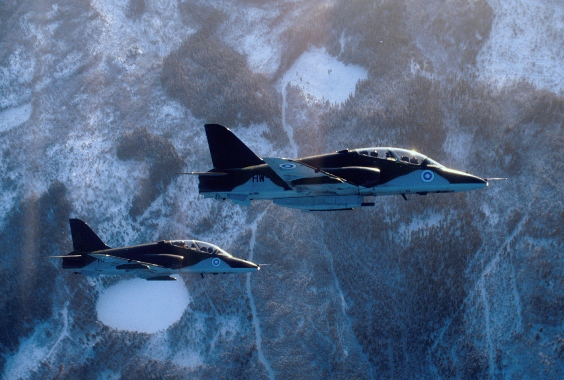
The Hawk jet trainer aircraft brought FINAF flight training up to date in the 1980s. Photo: Finnish Air Force
For the Air Force, the 1980s began with the introduction of new aircraft, as Satakunta Air Wing received the first delivery of Hawk advanced jet trainers from the UK.
The Hawk provided a good platform for pilot training and the training of fighter tactics towards the use of operational fighters.
Early in the decade, the Air Force also updated its liaison, transport and target-towing aircraft fleets. The new types of the era were the Fokker F27, the Learjet 35 A/S and the Piper Chieftain. All these acquisitions proved successful, as testified by the fact that each of the three aircraft types served the Air Force for decades.
Until the 1980s, FINAF fighter and interceptor fleet consisting of the Soviet-built MiG and the Swedish Draken aircraft were based in Karelia Air Wing and Lapland Air Wing, respectively. Originally, Satakunta Air Wing’s main equipment were jet trainers, first the Fouga Magister and then the Hawk.
Upon its relocation from Pori to Pirkkala in 1985, Satakunta Air Wing received Draken aircraft for use as fighters. At the same time, acquisitions of MiG-21bis aircraft continued as well. Ageing MiG-21F aircraft were replaced with the bis version both at Karelia Air Wing and the Reconnaissance Squadron operating at Luonetjärvi.
During the 1980s and 1990s, many different aspects of air defence were developed, including fighter aircraft tactics and command and control systems. The fighter aircraft fleet also underwent modification programmes to maintain and improve its capability so as to serve purposefully until the late stages of its life-cycle, roughly estimated to reach the turn of the millennium.
In the 1990s, the liaison aircraft fleet was strengthened with the acquisition of the Valmet Redigo that, as at present, remains the last military aircraft designed and built in Finland. Additionally, new acquisitions of Hawk aircraft were made in 1993 to supplement the existing fleet.
In the late 1980s, the Air Force started to look for a successor to the ageing Draken and MiG fleets that had begun to fall behind the international peak in performance terms.
The different fighter aircraft offered for consideration were the Mirage 2000-5 from France, the JAS 39 Gripen from Sweden, the F-16 C/D Fighting Falcon and the F-18 C/D Hornet from the United States and the MiG-29 from the Soviet Union. The first four of these were selected for further evaluation, with their test flights taking place at Halli in winter 1992.
In a procurement decision announced publicly in May 1992, the Air Force selected the McDonnell Douglas (now Boeing) F-18 Hornet as its next fighter aircraft type. In conjunction with the acquisition, the parties reached an agreement concerning extensive assembly arrangements for the aircraft to take place in Finland, along similar lines as in the acquisitions of the Fouga Magister, the Draken and the Hawk.
Ultimately 57 single-seat Hornets were assembled in Finland and seven two-seaters in the United States. Familiarisation of personnel with the new aircraft type begun in 1994 when pilots and aircraft maintenance personnel were sent to the USA for training in preparation of the Hornet's introduction.
The Hornet era (from 1995 onwards)
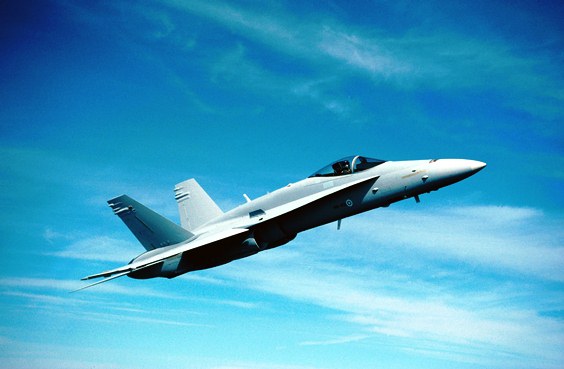
The Hornet has been in FINAF use for more than 20 years. Photo: Finnish Air Force
The acquisition of the Hornet meant the beginning of a new era in the Air Force. This modern and capable main equipment has formed a solid foundation for the development of air defence.
The Air Force received its first Hornets – six two-seat F-18D models – in November 1995 when they were flown from the United States to Pirkkala. In the following year, the first single-seat F-18C was built in Patria Finavitec's production line. The entire production series was completed in 2000, and all three wings of the Finnish Air Force were equipped with the new fighter aircraft in that year.
The transition from the Draken and the MiG-21 into the Hornet, an aircraft representing a much more advanced fighter generation, meant a substantial leap ahead for the Air Force.
Among the most significant features of the new aircraft were the pulse-doppler radar and the effective radar-guided AMRAAM missiles. They improved the Air Force's situational awareness and considerably added to the air defence capability over greater distances than before.
The Hornet's digital systems also substantially relieve the pilot's workload. They have been designed to support a wide variety of upgrades. Additionally, it was possible to connect the aircraft into the indigenous advanced air defence command and control system introduced in the late 1990s.
The Hornet era has also meant closer international co-operation for the Air Force.
After Finland's entry into the European Union and NATO's Partnership for Peace programme, the Air Force has participated in international air exercises both in Finland and abroad since 2000.
Through its international connections, the Air Force gets great perspectives on global developments in military aviation as well as opportunities to adopt internationally tried-and-tested practices and procedures as part of its own operations and to train air defence activities realistically together with the world's best air forces.
Furthermore, in compliance with its obligations stated in the 2004 Government Security and Defence Policy Report, the Air Force has established and evaluated an expeditionary unit to participate in international military crisis management operations.
Since the beginning of 2010, the Air Force has had the opportunity to assign a flight detachment of six Hornet fighters and 250 personnel for the aforementioned purpose, but for this to happen, a separate government decision is required and the unit must be set up.
After the completion of the Hornet acquisition, the Air Force has replaced other aircraft as well in the 2000s. In 2007, the Air Force acquired CASA C-295M transport aircraft to replace the Fokker F27, and in 2010 it introduced the Swiss-built Pilatus PC-12NG liaison aircraft replacing the Piper Chieftain and the Valmet Redigo fleets.
Furthermore, in 2011, a number of Hawk Mk 66 advanced jet trainers were acquired from the Swiss Air Force and introduced in Finland. They entered flight training service, replacing some of the oldest Hawks that had the most flight hours behind them. All Hawks remaining in service for the future will undergo a cockpit modernisation programme. 2016 saw the beginning of deliveries of Grob G 115E primary and basic trainers to the Air Force to replace the old Vinkas. The Vinka was retired in the beginning of September 2022.
Among the changes made in the 1990s was the reassignment of the Finnish Defence Forces’ helicopter operations, a FINAF responsibility since the 1960s, to the Army at Utti Jaeger Regiment. In 1997, the Transport Squadron, formerly based at Utti, was relocated to Tikkakoski, where it operated under the name Supporting Air Operations Squadron until the Defence Forces Reform implemented beginning from 2012.
The Air Force training system was updated in the mid-2000s. In 2005, the Finnish defence industry group Patria, which has been involved in the maintenance, repair and assembly of aircraft since the early days of the Air Force, was entrusted with the provision of basic flight training on Vinkas.
In view of this co-operation, the Vinka fleet previously based for the most part at Kauhava was relocated to Tikkakoski. The co-operation with Patria continues with the Grob fleet.
At the same time, the Hawk fleet, formerly dispersed to the air commands, was transferred to Kauhava, where the advanced training and tactical flight training of FINAF pilots was provided as a concentrated effort.
In this context, the Air Force Academy that operated at Kauhava was renamed the Training Air Wing while the Air Force C3 Systems School at Tikkakoski was given the name Air Force Academy.
In the Defence Forces Reform commenced in 2012, the organisational structure of the Air Force underwent some of the most comprehensive changes during the Service's entire history.
In the reform, the Hornet flight operations were concentrated to Lapland and Karelia Air Wings. From that time on, Satakunta Air Wing focused on supporting air operations as well as testing and research, and the Flight Test Centre, previously based at Halli, was merged into the Air Combat Centre that is part of the air wing. Furthermore, the Supporting Air Operations Squadron was also transferred to operate under the air wing. In addition, the Air Force's Hawk jet training as well as aircraft and weapon systems training were concentrated to the Air Force Academy at Tikkakoski. As a result, the Aircraft and Weapon Systems Training Wing was disbanded at the end of 2013 and the Training Air Wing one year later.
In the same context, the Air Force disbanded 3th Control and Reporting Centre at Satakunta Air Wing and established the Air Operations Centre that is responsible for the command and control of Finland's air defence operations and is administratively part of the Air Force Command. Moreover, the Air Force Materiel Command was merged into the new Defence Forces Logistics Command.

CASA C-295M transport aircraft are among the equipment acquired by the Air Force in the 2000s. Photo: Finnish Air Force
Throughout its existence, the Air Force has strived to develop its capabilities. The Service currently has schemes in progress to secure the striking power of Finnish air defence into the future.
The present decade’s projects include replacement and upgrading of air surveillance radar equipment and mid-life upgrades (MLU) on the Hornet fleet.
In the context of MLU 1 and MLU 2 completed on the Hornets in 2016, their air-to-air combat capabilities were improved and modifications and acquisitions were made to secure their remaining life-cycle. Additionally, the air-to-ground capabilities of the Hornets, originally designed as multi-role fighters, were introduced in the Air Force. To indicate this, the "A" letter was added to the Finnish Hornets’ type designation F/A-18 denoting their air-to-ground capability, familiarly from the designation practices applied by the United States, the principal operator of the aircraft type.
With the air-to-ground capability, the Air Force prepares to support its own combat activities as well as those of the other Services through the use of long-range precision weapons, in addition to undertaking defensive counter-air operations.
While the Air Force is ensuring that the Hornets stay capable for their remaining life-cycle, the Service is also preparing for the time beyond the end of their service life.
Finland's next multi-role fighter will be the Lockheed Martin F-35A Lightning II. The current Hornet fleet will be phased out as planned from the year 2025. The first Finnish F-35 fighters will begin service with the Finnish Air Force in 2025 as part of the training of Finnish personnel in the United States. The first F-35s will be delivered to Finland in 2026. In Finland the F-35 system will replace the Hornet fleet in the fighter wings between 2028 and 2030.




